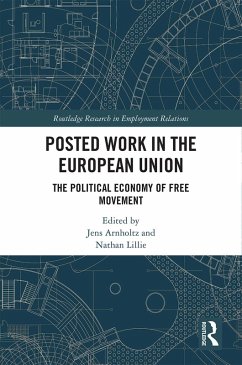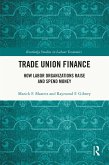Posted Work in the European Union (eBook, PDF)
The Political Economy of Free Movement
Redaktion: Arnholtz, Jens; Lillie, Nathan
44,95 €
44,95 €
inkl. MwSt.
Sofort per Download lieferbar

22 °P sammeln
44,95 €
Als Download kaufen

44,95 €
inkl. MwSt.
Sofort per Download lieferbar

22 °P sammeln
Jetzt verschenken
Alle Infos zum eBook verschenken
44,95 €
inkl. MwSt.
Sofort per Download lieferbar
Alle Infos zum eBook verschenken

22 °P sammeln
Posted Work in the European Union (eBook, PDF)
The Political Economy of Free Movement
Redaktion: Arnholtz, Jens; Lillie, Nathan
- Format: PDF
- Merkliste
- Auf die Merkliste
- Bewerten Bewerten
- Teilen
- Produkt teilen
- Produkterinnerung
- Produkterinnerung

Bitte loggen Sie sich zunächst in Ihr Kundenkonto ein oder registrieren Sie sich bei
bücher.de, um das eBook-Abo tolino select nutzen zu können.
Hier können Sie sich einloggen
Hier können Sie sich einloggen
Sie sind bereits eingeloggt. Klicken Sie auf 2. tolino select Abo, um fortzufahren.

Bitte loggen Sie sich zunächst in Ihr Kundenkonto ein oder registrieren Sie sich bei bücher.de, um das eBook-Abo tolino select nutzen zu können.
This book explores how posting is changing industrial relations systems in several European countries from a variety of disciplinary perspectives. It looks at how opportunities to set up shell-companies and engage in unregulated transnational recruitment made a Europe-wide industry out of avoiding regulation and cheating workers.
- Geräte: PC
- mit Kopierschutz
- eBook Hilfe
Andere Kunden interessierten sich auch für
![Posted Work in the European Union (eBook, ePUB) Posted Work in the European Union (eBook, ePUB)]() Posted Work in the European Union (eBook, ePUB)44,95 €
Posted Work in the European Union (eBook, ePUB)44,95 €![Trade Unions in the Course of European Integration (eBook, PDF) Trade Unions in the Course of European Integration (eBook, PDF)]() Martin SeeligerTrade Unions in the Course of European Integration (eBook, PDF)44,95 €
Martin SeeligerTrade Unions in the Course of European Integration (eBook, PDF)44,95 €![The Routledge Companion to Employment Relations (eBook, PDF) The Routledge Companion to Employment Relations (eBook, PDF)]() The Routledge Companion to Employment Relations (eBook, PDF)44,95 €
The Routledge Companion to Employment Relations (eBook, PDF)44,95 €![The Dynamics of Asian Labour Markets (eBook, PDF) The Dynamics of Asian Labour Markets (eBook, PDF)]() The Dynamics of Asian Labour Markets (eBook, PDF)48,95 €
The Dynamics of Asian Labour Markets (eBook, PDF)48,95 €![Union Organizing (eBook, PDF) Union Organizing (eBook, PDF)]() Gregor GallUnion Organizing (eBook, PDF)29,95 €
Gregor GallUnion Organizing (eBook, PDF)29,95 €![Trade Union Finance (eBook, PDF) Trade Union Finance (eBook, PDF)]() Marick F. MastersTrade Union Finance (eBook, PDF)42,95 €
Marick F. MastersTrade Union Finance (eBook, PDF)42,95 €![Employment, Trade Unionism, and Class (eBook, PDF) Employment, Trade Unionism, and Class (eBook, PDF)]() Gregoris IoannouEmployment, Trade Unionism, and Class (eBook, PDF)44,95 €
Gregoris IoannouEmployment, Trade Unionism, and Class (eBook, PDF)44,95 €-
-
-
This book explores how posting is changing industrial relations systems in several European countries from a variety of disciplinary perspectives. It looks at how opportunities to set up shell-companies and engage in unregulated transnational recruitment made a Europe-wide industry out of avoiding regulation and cheating workers.
Dieser Download kann aus rechtlichen Gründen nur mit Rechnungsadresse in A, B, BG, CY, CZ, D, DK, EW, E, FIN, F, GR, HR, H, IRL, I, LT, L, LR, M, NL, PL, P, R, S, SLO, SK ausgeliefert werden.
Produktdetails
- Produktdetails
- Verlag: Taylor & Francis eBooks
- Seitenzahl: 226
- Erscheinungstermin: 8. Oktober 2019
- Englisch
- ISBN-13: 9780429633744
- Artikelnr.: 57876326
- Verlag: Taylor & Francis eBooks
- Seitenzahl: 226
- Erscheinungstermin: 8. Oktober 2019
- Englisch
- ISBN-13: 9780429633744
- Artikelnr.: 57876326
- Herstellerkennzeichnung Die Herstellerinformationen sind derzeit nicht verfügbar.
Acknowledgements
Chapter 1 - European Integration and the Reconfiguration of National
Industrial Relations: Posted Work as a Driver of Institutional Change
Jens Arnholtz and Nathan Lillie
1.1 The socio-economic drivers of EU posting
1.2 Competing legal principles and the fundamental tension of posted work
1.3 Firm practices as the driver of change
1.4 Pressure on domestic institutions and incremental change
1.5 Enforcement actors and creative re-enactment of institutions
1.6 National institutional change in response to posted work
1.7 Feedback and European level changes
1.8 The chapters and their contribution to the argument
1.9 Conclusions
References
Chapter 2 - The benefits of posting: Facts and figures on the use and
impact of intra-EU posting
Frederic De Wispelaere and Jozef Pacolet
2.1 Introduction
2.2 'The posted worker': A multifaceted notion with a very concentrated
impact
2.2.1 Intra-EU posting 'at a glance'
2.2.2 The evolution of intra-EU posting
2.2.3 Some characteristics of intra-EU posting
2.2.4 The impact of intra-EU posting on national labour markets
2.3 Are we blinded by the potential negative consequences of intra-EU
posting?
2.3.1 Benefits of intra-EU posting from the perspective of the Member State
of origin
2.3.2 Higher wages and purchasing power for posted workers
2.3.3 Higher tax revenues from posted workers
2.3.4 Intra-EU posting as adjustment mechanism for economic shocks
2.4 Benefits of intra-EU posting from the perspective of the host Member
State
2.4.1 Various motives to use intra-EU posting
2.4.2 Does intra-EU posting lead to lower costs and prices?
2.5 The more we know about posting, the better we can discuss it:
Perception vs reality
References
Chapter 3 - Shifting employer strategies in light of institutional change
Kristin Alsos and Anne Mette Ødegård
3.1 The Norwegian labour market model meets a new reality
3.2 Analytical framework
3.3 Methods
3.4 First phase - 2004-2008: use of posted workers and extension of
collective agreement
3.5 Second phase 2009-2013: Individual labour migrants and new court
battles
3.6 Third phase 2013- 2018: The puzzle on equal treatment and closure?
3.7 Discussion and conclusion
References
Chapter 4 - Ambiguous mobility: Polish transnational workers navigating and
changing the institutional landscape of posting
Anna Matyska
4.1 Transnational mobility regimes, institutions, and institutional change
4.2 Posted work and institutional ambiguity
4.3 The departure: Allowing for the ambiguity
4.4 Collaboration and compliance
4.5 From asking around to facing a state institution
4.6 Trade unionisation
4.7 Institutional navigation and incremental changes
4.8 Concluding remarks
References
Chapter 5 - A comparative analysis of union responses to posted work in
four European countries
Nathan Lillie, Lisa Berntsen, Ines Wagner, and Sonila Danaj
5.1 Introduction
5.2 How does posting affect union rights?
5.3 Union responses to posted work
5.3.1 Migrant worker engagement
5.3.2 Political influence and regulatory enforcement
5.3.3 Collective agreement extension and enforcement
5.3.4 Site-level structures
5.4 Finland
5.5 The Netherlands
5.6 Germany
5.7 The United Kingdom
5.8 Analysis
References
Chapter 6 - Italian labour inspectors facing posted workers phenomena
6.1 Introduction
6.2 The instrument of posting in Italy: Sectoral and geographical
trajectories
6.3 Business strategies and irregularities of posting
6.4 Labour Inspectorate' actions: Dealing with complexity
6.5 Changing regulatory framework: New approaches towards posting
6.6 Conclusion
References
Chapter 7 - Market integration, cross-border recruitment, and enforcement
of labour standards - A Dutch case
7.1 Cross-border labour mobility and enforcement - Introduction
7.2 Working method
7.3 The role and function of the Dutch labour inspectorate
7.4 The Dutch instruments for enhanced compliance control based on the 2013
social pact
7.5 Assessment of the intensified compliance and enforcement policy
7.6 Business models and regulatory engagement strategies for circumventing
enforcement
7.6.1 Fraudulent contracting/pay-rolling
7.6.2 Chains of subcontracting
7.6.3 Foreign legal (artificial) entities
7.6.4 Posting of workers as a labour cost-saving method
7.6.5 Regime shopping in the field of social security
7.7 The Dutch practice against the background of EU experiences
7.8 Cross-border recruitment, compliance, and enforcement - Some
conclusions
References
Chapter 8 - Posting of workers: from a blurred notion associated with
'cheap labour' to a tool for 'fair labour mobility'?
Mijke Houwerzijl and Lisa Berntsen
8.1 Introduction
8.2 The legal framework of intra-EU labour mobility in an enlarged internal
market
8.3 Experiences and perceptions of posting in practice
8.3.1 Corporate strategies
8.3.2 Worker Perceptions and preferences regarding the employment status
8.3.4 Experiences of work and rights enforcement
8.4 Towards a comprehensive set of regulatory responses at the EU level:
Enough to disassociate posting from social dumping?
8.5 Concluding remarks
References
Chapter 9 - Stepping stones over troubled waters. Recent legal evolutions
and the reform of the Posting of Workers Directive
Marco Rocca
9.1 Introduction
9.2 The Reform
9.2.1 Remuneration
9.2.2 Collective agreements
9.3 Stepping stones
9.3.1 Evolving Case Law
9.3.2 Public procurement
9.3.3 The National Level
9.4 Conclusions
References
Chapter 10 - Labour Subcontracting in Cross-Border Labour Markets: A
Comparison of Rule Evasion in Germany and Japan
Ines Wagner and Karen Shire
1. Introduction
2. Dispatched Work in Japan
3. The Posting of Workers Regulation and Germany
4. The Layering of Immigration and Dispatching Regulations in Japan
5. Regulatory arbitrage through Posting in Germany
6. Regulatory displacement through dispatching in Japan
7. Conclusion
References
Author Biographies
Index
Chapter 1 - European Integration and the Reconfiguration of National
Industrial Relations: Posted Work as a Driver of Institutional Change
Jens Arnholtz and Nathan Lillie
1.1 The socio-economic drivers of EU posting
1.2 Competing legal principles and the fundamental tension of posted work
1.3 Firm practices as the driver of change
1.4 Pressure on domestic institutions and incremental change
1.5 Enforcement actors and creative re-enactment of institutions
1.6 National institutional change in response to posted work
1.7 Feedback and European level changes
1.8 The chapters and their contribution to the argument
1.9 Conclusions
References
Chapter 2 - The benefits of posting: Facts and figures on the use and
impact of intra-EU posting
Frederic De Wispelaere and Jozef Pacolet
2.1 Introduction
2.2 'The posted worker': A multifaceted notion with a very concentrated
impact
2.2.1 Intra-EU posting 'at a glance'
2.2.2 The evolution of intra-EU posting
2.2.3 Some characteristics of intra-EU posting
2.2.4 The impact of intra-EU posting on national labour markets
2.3 Are we blinded by the potential negative consequences of intra-EU
posting?
2.3.1 Benefits of intra-EU posting from the perspective of the Member State
of origin
2.3.2 Higher wages and purchasing power for posted workers
2.3.3 Higher tax revenues from posted workers
2.3.4 Intra-EU posting as adjustment mechanism for economic shocks
2.4 Benefits of intra-EU posting from the perspective of the host Member
State
2.4.1 Various motives to use intra-EU posting
2.4.2 Does intra-EU posting lead to lower costs and prices?
2.5 The more we know about posting, the better we can discuss it:
Perception vs reality
References
Chapter 3 - Shifting employer strategies in light of institutional change
Kristin Alsos and Anne Mette Ødegård
3.1 The Norwegian labour market model meets a new reality
3.2 Analytical framework
3.3 Methods
3.4 First phase - 2004-2008: use of posted workers and extension of
collective agreement
3.5 Second phase 2009-2013: Individual labour migrants and new court
battles
3.6 Third phase 2013- 2018: The puzzle on equal treatment and closure?
3.7 Discussion and conclusion
References
Chapter 4 - Ambiguous mobility: Polish transnational workers navigating and
changing the institutional landscape of posting
Anna Matyska
4.1 Transnational mobility regimes, institutions, and institutional change
4.2 Posted work and institutional ambiguity
4.3 The departure: Allowing for the ambiguity
4.4 Collaboration and compliance
4.5 From asking around to facing a state institution
4.6 Trade unionisation
4.7 Institutional navigation and incremental changes
4.8 Concluding remarks
References
Chapter 5 - A comparative analysis of union responses to posted work in
four European countries
Nathan Lillie, Lisa Berntsen, Ines Wagner, and Sonila Danaj
5.1 Introduction
5.2 How does posting affect union rights?
5.3 Union responses to posted work
5.3.1 Migrant worker engagement
5.3.2 Political influence and regulatory enforcement
5.3.3 Collective agreement extension and enforcement
5.3.4 Site-level structures
5.4 Finland
5.5 The Netherlands
5.6 Germany
5.7 The United Kingdom
5.8 Analysis
References
Chapter 6 - Italian labour inspectors facing posted workers phenomena
6.1 Introduction
6.2 The instrument of posting in Italy: Sectoral and geographical
trajectories
6.3 Business strategies and irregularities of posting
6.4 Labour Inspectorate' actions: Dealing with complexity
6.5 Changing regulatory framework: New approaches towards posting
6.6 Conclusion
References
Chapter 7 - Market integration, cross-border recruitment, and enforcement
of labour standards - A Dutch case
7.1 Cross-border labour mobility and enforcement - Introduction
7.2 Working method
7.3 The role and function of the Dutch labour inspectorate
7.4 The Dutch instruments for enhanced compliance control based on the 2013
social pact
7.5 Assessment of the intensified compliance and enforcement policy
7.6 Business models and regulatory engagement strategies for circumventing
enforcement
7.6.1 Fraudulent contracting/pay-rolling
7.6.2 Chains of subcontracting
7.6.3 Foreign legal (artificial) entities
7.6.4 Posting of workers as a labour cost-saving method
7.6.5 Regime shopping in the field of social security
7.7 The Dutch practice against the background of EU experiences
7.8 Cross-border recruitment, compliance, and enforcement - Some
conclusions
References
Chapter 8 - Posting of workers: from a blurred notion associated with
'cheap labour' to a tool for 'fair labour mobility'?
Mijke Houwerzijl and Lisa Berntsen
8.1 Introduction
8.2 The legal framework of intra-EU labour mobility in an enlarged internal
market
8.3 Experiences and perceptions of posting in practice
8.3.1 Corporate strategies
8.3.2 Worker Perceptions and preferences regarding the employment status
8.3.4 Experiences of work and rights enforcement
8.4 Towards a comprehensive set of regulatory responses at the EU level:
Enough to disassociate posting from social dumping?
8.5 Concluding remarks
References
Chapter 9 - Stepping stones over troubled waters. Recent legal evolutions
and the reform of the Posting of Workers Directive
Marco Rocca
9.1 Introduction
9.2 The Reform
9.2.1 Remuneration
9.2.2 Collective agreements
9.3 Stepping stones
9.3.1 Evolving Case Law
9.3.2 Public procurement
9.3.3 The National Level
9.4 Conclusions
References
Chapter 10 - Labour Subcontracting in Cross-Border Labour Markets: A
Comparison of Rule Evasion in Germany and Japan
Ines Wagner and Karen Shire
1. Introduction
2. Dispatched Work in Japan
3. The Posting of Workers Regulation and Germany
4. The Layering of Immigration and Dispatching Regulations in Japan
5. Regulatory arbitrage through Posting in Germany
6. Regulatory displacement through dispatching in Japan
7. Conclusion
References
Author Biographies
Index
Acknowledgements
Chapter 1 - European Integration and the Reconfiguration of National
Industrial Relations: Posted Work as a Driver of Institutional Change
Jens Arnholtz and Nathan Lillie
1.1 The socio-economic drivers of EU posting
1.2 Competing legal principles and the fundamental tension of posted work
1.3 Firm practices as the driver of change
1.4 Pressure on domestic institutions and incremental change
1.5 Enforcement actors and creative re-enactment of institutions
1.6 National institutional change in response to posted work
1.7 Feedback and European level changes
1.8 The chapters and their contribution to the argument
1.9 Conclusions
References
Chapter 2 - The benefits of posting: Facts and figures on the use and
impact of intra-EU posting
Frederic De Wispelaere and Jozef Pacolet
2.1 Introduction
2.2 'The posted worker': A multifaceted notion with a very concentrated
impact
2.2.1 Intra-EU posting 'at a glance'
2.2.2 The evolution of intra-EU posting
2.2.3 Some characteristics of intra-EU posting
2.2.4 The impact of intra-EU posting on national labour markets
2.3 Are we blinded by the potential negative consequences of intra-EU
posting?
2.3.1 Benefits of intra-EU posting from the perspective of the Member State
of origin
2.3.2 Higher wages and purchasing power for posted workers
2.3.3 Higher tax revenues from posted workers
2.3.4 Intra-EU posting as adjustment mechanism for economic shocks
2.4 Benefits of intra-EU posting from the perspective of the host Member
State
2.4.1 Various motives to use intra-EU posting
2.4.2 Does intra-EU posting lead to lower costs and prices?
2.5 The more we know about posting, the better we can discuss it:
Perception vs reality
References
Chapter 3 - Shifting employer strategies in light of institutional change
Kristin Alsos and Anne Mette Ødegård
3.1 The Norwegian labour market model meets a new reality
3.2 Analytical framework
3.3 Methods
3.4 First phase - 2004-2008: use of posted workers and extension of
collective agreement
3.5 Second phase 2009-2013: Individual labour migrants and new court
battles
3.6 Third phase 2013- 2018: The puzzle on equal treatment and closure?
3.7 Discussion and conclusion
References
Chapter 4 - Ambiguous mobility: Polish transnational workers navigating and
changing the institutional landscape of posting
Anna Matyska
4.1 Transnational mobility regimes, institutions, and institutional change
4.2 Posted work and institutional ambiguity
4.3 The departure: Allowing for the ambiguity
4.4 Collaboration and compliance
4.5 From asking around to facing a state institution
4.6 Trade unionisation
4.7 Institutional navigation and incremental changes
4.8 Concluding remarks
References
Chapter 5 - A comparative analysis of union responses to posted work in
four European countries
Nathan Lillie, Lisa Berntsen, Ines Wagner, and Sonila Danaj
5.1 Introduction
5.2 How does posting affect union rights?
5.3 Union responses to posted work
5.3.1 Migrant worker engagement
5.3.2 Political influence and regulatory enforcement
5.3.3 Collective agreement extension and enforcement
5.3.4 Site-level structures
5.4 Finland
5.5 The Netherlands
5.6 Germany
5.7 The United Kingdom
5.8 Analysis
References
Chapter 6 - Italian labour inspectors facing posted workers phenomena
6.1 Introduction
6.2 The instrument of posting in Italy: Sectoral and geographical
trajectories
6.3 Business strategies and irregularities of posting
6.4 Labour Inspectorate' actions: Dealing with complexity
6.5 Changing regulatory framework: New approaches towards posting
6.6 Conclusion
References
Chapter 7 - Market integration, cross-border recruitment, and enforcement
of labour standards - A Dutch case
7.1 Cross-border labour mobility and enforcement - Introduction
7.2 Working method
7.3 The role and function of the Dutch labour inspectorate
7.4 The Dutch instruments for enhanced compliance control based on the 2013
social pact
7.5 Assessment of the intensified compliance and enforcement policy
7.6 Business models and regulatory engagement strategies for circumventing
enforcement
7.6.1 Fraudulent contracting/pay-rolling
7.6.2 Chains of subcontracting
7.6.3 Foreign legal (artificial) entities
7.6.4 Posting of workers as a labour cost-saving method
7.6.5 Regime shopping in the field of social security
7.7 The Dutch practice against the background of EU experiences
7.8 Cross-border recruitment, compliance, and enforcement - Some
conclusions
References
Chapter 8 - Posting of workers: from a blurred notion associated with
'cheap labour' to a tool for 'fair labour mobility'?
Mijke Houwerzijl and Lisa Berntsen
8.1 Introduction
8.2 The legal framework of intra-EU labour mobility in an enlarged internal
market
8.3 Experiences and perceptions of posting in practice
8.3.1 Corporate strategies
8.3.2 Worker Perceptions and preferences regarding the employment status
8.3.4 Experiences of work and rights enforcement
8.4 Towards a comprehensive set of regulatory responses at the EU level:
Enough to disassociate posting from social dumping?
8.5 Concluding remarks
References
Chapter 9 - Stepping stones over troubled waters. Recent legal evolutions
and the reform of the Posting of Workers Directive
Marco Rocca
9.1 Introduction
9.2 The Reform
9.2.1 Remuneration
9.2.2 Collective agreements
9.3 Stepping stones
9.3.1 Evolving Case Law
9.3.2 Public procurement
9.3.3 The National Level
9.4 Conclusions
References
Chapter 10 - Labour Subcontracting in Cross-Border Labour Markets: A
Comparison of Rule Evasion in Germany and Japan
Ines Wagner and Karen Shire
1. Introduction
2. Dispatched Work in Japan
3. The Posting of Workers Regulation and Germany
4. The Layering of Immigration and Dispatching Regulations in Japan
5. Regulatory arbitrage through Posting in Germany
6. Regulatory displacement through dispatching in Japan
7. Conclusion
References
Author Biographies
Index
Chapter 1 - European Integration and the Reconfiguration of National
Industrial Relations: Posted Work as a Driver of Institutional Change
Jens Arnholtz and Nathan Lillie
1.1 The socio-economic drivers of EU posting
1.2 Competing legal principles and the fundamental tension of posted work
1.3 Firm practices as the driver of change
1.4 Pressure on domestic institutions and incremental change
1.5 Enforcement actors and creative re-enactment of institutions
1.6 National institutional change in response to posted work
1.7 Feedback and European level changes
1.8 The chapters and their contribution to the argument
1.9 Conclusions
References
Chapter 2 - The benefits of posting: Facts and figures on the use and
impact of intra-EU posting
Frederic De Wispelaere and Jozef Pacolet
2.1 Introduction
2.2 'The posted worker': A multifaceted notion with a very concentrated
impact
2.2.1 Intra-EU posting 'at a glance'
2.2.2 The evolution of intra-EU posting
2.2.3 Some characteristics of intra-EU posting
2.2.4 The impact of intra-EU posting on national labour markets
2.3 Are we blinded by the potential negative consequences of intra-EU
posting?
2.3.1 Benefits of intra-EU posting from the perspective of the Member State
of origin
2.3.2 Higher wages and purchasing power for posted workers
2.3.3 Higher tax revenues from posted workers
2.3.4 Intra-EU posting as adjustment mechanism for economic shocks
2.4 Benefits of intra-EU posting from the perspective of the host Member
State
2.4.1 Various motives to use intra-EU posting
2.4.2 Does intra-EU posting lead to lower costs and prices?
2.5 The more we know about posting, the better we can discuss it:
Perception vs reality
References
Chapter 3 - Shifting employer strategies in light of institutional change
Kristin Alsos and Anne Mette Ødegård
3.1 The Norwegian labour market model meets a new reality
3.2 Analytical framework
3.3 Methods
3.4 First phase - 2004-2008: use of posted workers and extension of
collective agreement
3.5 Second phase 2009-2013: Individual labour migrants and new court
battles
3.6 Third phase 2013- 2018: The puzzle on equal treatment and closure?
3.7 Discussion and conclusion
References
Chapter 4 - Ambiguous mobility: Polish transnational workers navigating and
changing the institutional landscape of posting
Anna Matyska
4.1 Transnational mobility regimes, institutions, and institutional change
4.2 Posted work and institutional ambiguity
4.3 The departure: Allowing for the ambiguity
4.4 Collaboration and compliance
4.5 From asking around to facing a state institution
4.6 Trade unionisation
4.7 Institutional navigation and incremental changes
4.8 Concluding remarks
References
Chapter 5 - A comparative analysis of union responses to posted work in
four European countries
Nathan Lillie, Lisa Berntsen, Ines Wagner, and Sonila Danaj
5.1 Introduction
5.2 How does posting affect union rights?
5.3 Union responses to posted work
5.3.1 Migrant worker engagement
5.3.2 Political influence and regulatory enforcement
5.3.3 Collective agreement extension and enforcement
5.3.4 Site-level structures
5.4 Finland
5.5 The Netherlands
5.6 Germany
5.7 The United Kingdom
5.8 Analysis
References
Chapter 6 - Italian labour inspectors facing posted workers phenomena
6.1 Introduction
6.2 The instrument of posting in Italy: Sectoral and geographical
trajectories
6.3 Business strategies and irregularities of posting
6.4 Labour Inspectorate' actions: Dealing with complexity
6.5 Changing regulatory framework: New approaches towards posting
6.6 Conclusion
References
Chapter 7 - Market integration, cross-border recruitment, and enforcement
of labour standards - A Dutch case
7.1 Cross-border labour mobility and enforcement - Introduction
7.2 Working method
7.3 The role and function of the Dutch labour inspectorate
7.4 The Dutch instruments for enhanced compliance control based on the 2013
social pact
7.5 Assessment of the intensified compliance and enforcement policy
7.6 Business models and regulatory engagement strategies for circumventing
enforcement
7.6.1 Fraudulent contracting/pay-rolling
7.6.2 Chains of subcontracting
7.6.3 Foreign legal (artificial) entities
7.6.4 Posting of workers as a labour cost-saving method
7.6.5 Regime shopping in the field of social security
7.7 The Dutch practice against the background of EU experiences
7.8 Cross-border recruitment, compliance, and enforcement - Some
conclusions
References
Chapter 8 - Posting of workers: from a blurred notion associated with
'cheap labour' to a tool for 'fair labour mobility'?
Mijke Houwerzijl and Lisa Berntsen
8.1 Introduction
8.2 The legal framework of intra-EU labour mobility in an enlarged internal
market
8.3 Experiences and perceptions of posting in practice
8.3.1 Corporate strategies
8.3.2 Worker Perceptions and preferences regarding the employment status
8.3.4 Experiences of work and rights enforcement
8.4 Towards a comprehensive set of regulatory responses at the EU level:
Enough to disassociate posting from social dumping?
8.5 Concluding remarks
References
Chapter 9 - Stepping stones over troubled waters. Recent legal evolutions
and the reform of the Posting of Workers Directive
Marco Rocca
9.1 Introduction
9.2 The Reform
9.2.1 Remuneration
9.2.2 Collective agreements
9.3 Stepping stones
9.3.1 Evolving Case Law
9.3.2 Public procurement
9.3.3 The National Level
9.4 Conclusions
References
Chapter 10 - Labour Subcontracting in Cross-Border Labour Markets: A
Comparison of Rule Evasion in Germany and Japan
Ines Wagner and Karen Shire
1. Introduction
2. Dispatched Work in Japan
3. The Posting of Workers Regulation and Germany
4. The Layering of Immigration and Dispatching Regulations in Japan
5. Regulatory arbitrage through Posting in Germany
6. Regulatory displacement through dispatching in Japan
7. Conclusion
References
Author Biographies
Index







